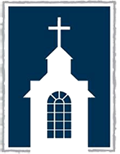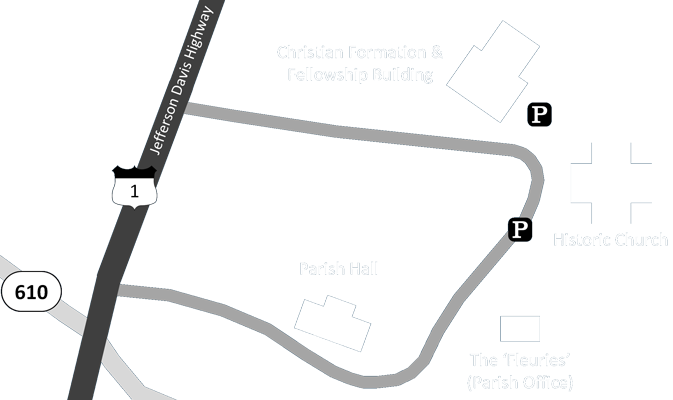The Civil War at Aquia Church
The Confederate Army at Aquia Church
Confederate Graffiti
The Union Army at Aquia Church
The Union Army of the Potomac arrived in Stafford County in November of 1862 and set up there winter camp. Thousands of soldiers encamped in Stafford, with Aquia Church located at the northern exterior line of defense.[10] The 9th New York Cavalry arrived at Aquia Church on February 11, 1863 and quickly received "strict orders were given against cutting any timber within 1,000 yards of the church."[11] On February 14, the 17th Pennsylvania Cavalry arrived at Aquia Church, which made an immediate impression on the Union soldiers,
"This was a beautiful place, located on high ground in a fine oak grove. The church building had the following inscription: "Built A. D. 1751. Destroyed by fire, 1754. Rebuilt, 1757." The citizens in the vicinity claimed that Washington, Lafayette and other great men of Revolutionary times had worshipped in this chapel. During our short stay at this beautiful spot several religious services were held in this church in charge of our regimental chaplain, Rev. Henry Wheeler. The building being only a small one, it was crowded by the members of the regiment every time services were held."[12]
Rev. Henry Wheeler
Rev. Henry Wheeler was an abolitionist who earlier in the year, had gotten in trouble for a sermon with these themes, "My sermon was objected to because it was in favor of abolition of the slaves, but the country and people will learn what is God's plan in this great work when they have suffered enough. God grant it may be in time to save the nation."[13] When he came upon Aquia Church, he was familiar with the area because of the celebrity of abolitionist Rev. Moncure D. Conway.[14] He recounts his efforts to protect the church and use it for services,
"I liked the appearance of the church and set myself about getting it for religious purposes. I found a guard placed there by General Kane, to protect the church. I went to General Kane and obtained an interview with him. I found him to be a pleasant, affable gentleman. He was a brother of the great explorer, Elisha Kent Kane. I asked him to give me permission to use the church for religious purposes. He said, "I sent the guard there without being asked to do so by the vestry, and of course I can take it away at my pleasure. I am glad, Mr. Wheeler, that I have an opportunity of showing, at least once, that I consider the two churches, Protestant Episcopal and Methodist Episcopal as one." He at once gave me a written order, which now lies before me :
'HEADQUARTERS, SECOND BRIGADE, FIRST Div TWELFTH A. C., NEAR STAFFORD CHURCH, VA., FEBRUARY 13, 1863.
The guard from this brigade, stationed at Acquia Church, will be subject to the orders of Rev. Mr. Wheeler, Chaplain Seventeenth Pennsylvania Cavalry.
By order of Brigadier-general Kane,
JNO. P. GREEN, Capt. & A. A. G.'
I expressed my thanks to the general for his kindness and retired. This was the only time the chaplain was "in command" while in the army. The guard was sent back to their regiment, and men of the Seventeenth were detailed to clean the church and put it in condition for religious service."[15]
Rev. Wheeler had regular services at Aquia Church, including funeral services for fallen union soldiers,
"Here some of our men died of fever, and some were killed while on picket duty. Some bodies were sent home in coffins made of cracker boxes, and others were buried here. On March 1, 1863, Harvey Seawright, of Company A, was buried with military honors, a man highly respected by his comrades. Funeral service was held in the church, which was filled. The chaplain preached from II Samuel 14:14, 'For we must needs die, and are as water spilt upon the ground, which cannot be gathered up again; neither doth God respect any person: yet doth He devise means that His banished be not expelled from Him.'"[16]
Harvey Seawright is one of the six unknown Union soldiers who were originally buried at Aquia Church who were moved to the Fredericksburg National Cemetery after the war. In addition to these six, there are six more soldiers who were buried at Aquia who were reinterred at the Fredericksburg National Cementery with named headstones. These soldiers are listed below with their grave number:
- (5555) Henry Basler Private. Co.H, 119 PA. Mustered in 23 Aug., 1862 for three years. Died at Stafford Court House 29 Nov., 1862
- (5562) N. Eaton Private. Co.K, 150 PA. Died 18 Jan., 1863
- (5560) Edwin E. Roberts (FVC has F.) Private. Co.F, 133 PA. Mustered in 15 Aug, 1862 for nine months. Home was Ebensburg. Died at Aquia Creek 17 Jan, 1863
- (5561) Henry Rock Private. Co.F, U.S. Died 1863
- (5235) Albert Snyder Private. Co.F, 157 NY. Age 24. Enlisted 31 Aug., 1862 at Smithfield for three years and mustered in 19 Sept., 1862. Died of brain fever 4 Jan., 1863 at Aquia Creek
- (5559) Warren D. Thompson Private. Co. F, 5 WI. Res: Waukesha. Enlisted 10 May, 1861. Died 28 Nov, 1862, at Aquia of disease [17]
Rev. Wheeler wrote some reflections about these soldiers buried at Aquia Church:
"The soldiers from the East, West and North lie buried by the side of the men of the house of Moncure. There is peace among those whom death has brought low. Death is the leveler of all distinctions, the settler of all strife. Friend and foe will rest together until the last day. The soldier has made his last retreat; no weapon can reach him now, but he will come forth to the last great roll call at the archangel's reveille. Is it possible that a base and traitorous flag will ever wave over the graves of our fallen heroes? God forbid! May the graves in which their ashes repose ever be guarded by the Stars and Stripes. Lightly they'll talk of the spirits now gone, and over their cold ashes upbraid them; But little they'll reck, if they let them sleep on in the graves where their comrades have laid them."[18]
Union Graffiti
The Union soldiers, like their Confederate counterparts, left behind graffiti both in the exterior and interior of the church. You can read the excellent blog series "If these signatures could talk..." by Eric Mink, local National Park Services Historian to read more about these Union soldiers. One signature not mentioned since it is located inside of the church on the railing leading to the third floor of the church, was made by Moses Babcock of Company D in the 6th Maine Infantry. Babcock was shot in the back at the 2nd Battle at Fredericksburg and visited the church while recovering from his wounds. He was born in Chester, Maine and before the war resided in Mattawamkeag, Maine. He was medically discharged and moved to Michigan where he died only 3 years later in Alpena, Michigan and is buried there in Evergreen Cemetery.
Rev. George Machenheimer leaves Aquia Church
During the Union Army of the Potomac's winter encampment, Rev. Machenheimer and his family still lived in Stafford County. His son had joined the Confederate 1st Maryland Light Artillery Battery, but was a trained doctor who later served as a hospital steward for the Confederate side. His sisters, Georgiana and Eliza, stayed with their parents in Stafford. On March 1, 1863, Henry Hastings Curran, an officer in the 146 New York Regiment who later died in the Battle of the Wilderness in Spotsylvania, wrote to his mother about meeting the Rev. Machenheimer and his family,
"I had no active duty during the day, except superintending about half a mile of the line, and the guarding of a secesh house, a little outside of the lines…An aged horse; a weazen-faced, sanctimonious little old man, with a long chin, and a much longer nose, and two sleek locks of hair darting from behind two enormous ears; a very demure looking cow, mourning the loss of her horns; and a small cat, that seemed to take great delight in lying on its back in the snow and pawing the air vigorously – these four gave the only signs of life about this quaint old Virginia house, hidden among the trees. About dusk Pat. Thomas told me he had scraped the old man’s acquaintance, and was invited in to spend the evening. He also stated, there were young ladies there. So I went with him, and had a very pleasant time. He was an episcopal clergyman, rector of Acquia Church at Stafford C. H., a church which had been standing, as he said, with a smile of pleasure, not slightly tempered with pride, 110 years. His wife, a very calm statue-like old lady, was entertained by Lieut. Lowery. She was very deaf, but the lieutenant made a vigorous onset, and by the dint of load shouts, and placing his mouth in her ears (which, by the way were, unlike her husband’s, very small), probably passed a very happy evening. Pat. Thomas palmed himself off for a surgeon, and indulged in a very learned discussion with the old gentleman, who was quite inquisitive, and desired to learn much on various difficult operations and unusual diseases. I, being thus thrown upon the young lady, who proved to be very agreeable and quite refined, a niece of Surgeon General Hammond, of course passed a pleasant evening."[19]
Rev. George Machenheimer's wife, Eliza Page was the sister-in-law of the Rev. Jonathan Pinckney Hammond, the brother of the Surgeon General, William Alexander Hammond. Machenheimer used these connections to leave Stafford for Washington D.C. before the Union army left the county. In 1864, Machenheimer reports in the 81st Annual Convention of the Episcopal Church in Maryland as the Officiating Minister at Grace Church in Silver Spring Maryland that, "after an absence of three years, in discharge of his ministry in Virginia, under very unfavorable circumstances, produced by the war, he has returned to his native state, where he has spent most of his ministerial life, and has connected himself again with the Diocese of Maryland, by accepting an invitation to his present charge, which commenced on the first day of July 1863."[20]
Aquia Church recovers after the War
George V. Moncure, an active member of Aquia Church before the war, began in earnest to find a new rector for the church, sending letters and entreaty to his personal friend, Rev. Jaquelin M. Meredith a chaplain for the 47th Virginia Infantry.[21] The vestry met in October of 1864 electing Rev. Meredith, which he accepted the position in November.[22] The first year of his rectorship were difficult for the church. Rev. Meredith attested that George Moncure had "almost fed the Rector's family for twelve months" and at the end of the war only, "three out of 12 of the vestry were communicants" and the church's members totaled to seven.[23]
Aquia Church also suffered from damage from the war, besides the graffiti from Union and Confederate soldiers. Rev. Meredith listed the damage to the church that includes missing windows, "its walls defaced, its marble chancel floors torn up and broken."[24] The church's pews also suffered damage from the building being used as a stable for the cavalry's horses who chewed on the pews causing the pew height to be lowered when the church was renovated. The church's cemetery also suffered damage during the war. Rev. Wheeler noted that he had "taken the church from men who had made fireplaces of the gravestones."[25] Other damage to the cemetery was recorded in the Alexandria Gazette when "Federal soldiers from New Jersey sent back to the late John Carroll Brent, of Washington D.C., copper plates, with epitaphs, which had been dug out of the tombs of the Brents at this church."[26] The extent of the damage of the church was mitigated by the actions of Rev. Wheeler and also probably by Rev. Machenheimer's connections. Other colonial churches in Virginia, like Pohick and King George, suffered from extensive damage by the Union army. After the war, Rev. Wheeler was personally thanked by Moncure Daniel Conway's sister "for protecting the graves of her ancestors."[27]
Rev. Meredith and Moncure Robinson spent their personal funds to renovate the church within in a year after the war with the church recovering faster then it ever had before after a major war. By 1866, Bishop Johns visited Aquia Church to confirm 83 people.[28] Aquia Church also quickly established an extensive Sunday School in Stafford County and by 1870 had "repaired Aquia, rebuilding Clifton, rebuilding Quantico Church, and organized an independent congregation at Rockhill, West Stafford.[29]



